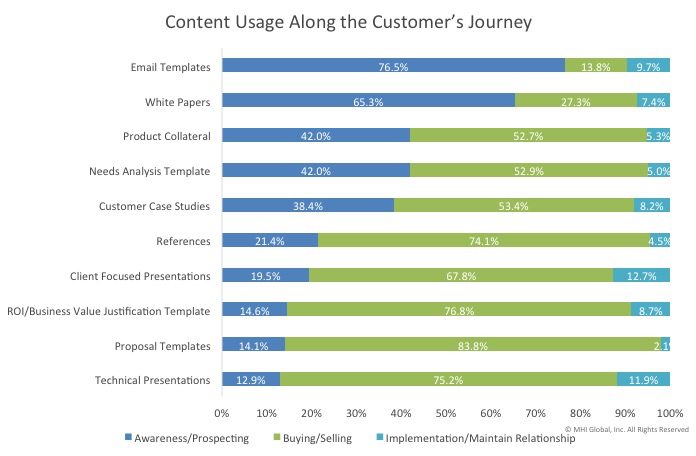Tell your prospect a story.
Recently we covered four common proposal pitfalls that are sabotaging your deals. Now we’re expanding on the proposal framework that can help take your proposals from review to close. When you have the proper framework for your proposal, you better communicate the necessary elements and your game-changing differentiators to your prospect, providing them with a compelling reason to choose you as their solution partner.
Before we get into the framework specifics, the most important thing to remember throughout the entire proposal process is to make the proposal about the prospect. This is not about you and what you can provide, but about them, their problem and how your solution will lead them to success.
People love stories. Stories resonate, stories illustrate and stories captivate. So when you arrange your proposal into a story format — featuring the prospect as the main character and protagonist — you will naturally compel your prospect to interact and react.
A compelling story — like an action adventure — starts with a villain (the pain). The hero (you, the solution) enters the fray to change the outcomes (the gain) for all parties. The story concludes with a big celebration highlighted on the front cover of the newspaper (the proof) about the victorious results.
That story formula — pain, solution, gain and proof — draws the buyer into the dialogue because it starts with them and positions the proposed scenario in their point-of-view. The story elements work together to create a bridge between the prospect and their pains, and you and your solutions.
Proposal Element 1: The Pain
First, when creating the content for the proposal, always begin with what we heard. This is your opportunity to speak specifically to the pains the client expressed in your discovery meeting and remind them of their own words.
Example: “John, when we talked on the phone last week, what we heard is that your team is struggling with “A.” You shared with us that you believe the reason for this is “B.”
It is important to remind them of why they contacted you in the first place, show them you were listening and have become an expert on their problem, bring them back to their pain and then drill down even further.
“Every moment you delay, you are losing more money. We need to fix these problems, and we need to fix them now.”
With the framing “what we heard”, you also have the opportunity to make refinements based on their confirmation of your situational summary. While respectful to them, it also fosters the partnership with your prospect.
Proposal Element 2: The Solution
Next, outline the solution essentials – that is, those solution capabilities that both you and any competitors (identified or potential) offer.
“When you work with us, here is the core package you’ll receive.”
This is your opportunity to set the bar. The prospect is likely having similar discussions with other solution providers, and you need to be sure to cover the essentials they are receiving everywhere else. You don’t want to miss important basics of what they need.
Following the solution essentials, it is time to bring your “wow factor” — your differentiators.
“But if you work with us, this is what you get above and beyond what you will receive elsewhere. This is the specific thing you will receive from our team that will take you to a whole new level of success.”
Earlier you set the bar with the essentials, and now you have the opportunity to raise it, setting-up an unfair competitive position™ for you in the mind of your prospect. They are receiving “A,” “B” and “C” everywhere else, but you need to expand on “D” — your competitive advantage — the factor that makes your solution worth the premium price you command. Make your differentiator the missing piece that truly solves their pain.
Proposal Element 3: The Gain
The next step, unveiling the solution outcome, will show the prospect the gain by choosing you.
“By working with us, the issue you came to us with will be solved.”
Discuss the outcomes in light of the “what we heard” summary you reviewed with your prospect earlier. Throughout the entire proposal you have been creating a sense of pain and urgency that has led you to this point. Now you are linking the gains they desire to the pains you spotlighted– with your solution as the only bridge between the two.
Proposal Element 4: The Proof
This is the final, most underutilized piece necessary to help the prospect choose you and your solution. Providing proof, through case studies, client testimonials and even solution demonstrations, when appropriate, will show you are more than talk.
“Here is an example of a client we worked with who was suffering from a similar issue, and this is what we did to not only solve their problem, but we were also able to help this key metric improve by 10%.”
Again, this is about the prospect and their pain, so show them they are not alone in their struggle — but more importantly, show them what it can look like on the other side of the chasm they find themselves today. Give them a visual, a written testimony or client value story, and you can even put them in touch with a customer reference. Alternatively, highlight the elements of your solution (ideally differentiators) in a demonstration that directly address their pain, and deliver the target results.
Prepare for the proposal.
You may be wondering who has time for all of this. Surely, not your sales team!
Our advice is to have a template prepared in advance. This is going to save your front-line sales team crucial time and energy. The CSO Insights’ 2016 Sales Enablement Optimization Study shows that proposal templates are the top assets sellers leverage in the buying phase (see image below). Proposal templates empower sellers to tailor the content to the customer’s unique buying scenario — versus creating the content from scratch. Empower marketing and product marketing teams to collaborate to develop proposal templates. This partnership ensures the content includes necessary building blocks.

By following this framework and including these essential pieces to your proposal, you are sure to close more deals. If you have any questions on how to guide your team through this process, don’t hesitate to reach out to us at information@mereo.co.
